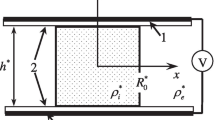Abstract.
The resonant modes of sessile water drops on a hydrophobic substrate subjected to a small-amplitude lateral vibration are investigated using computational fluid dynamic (CFD) modeling. As the substrate is vibrated laterally, its momentum diffuses within the Stokes layer of the drop. Above the Stokes layer, the competition between the inertial and Laplace forces causes the formation of capillary waves on the surface of the drop. In the first part of this paper, the resonant states of water drops are illustrated by investigating the velocity profile and the hydrostatic force using a 3d simulation of the Navier-Stokes equation. The simulation also allows an estimation of the contact angle variation on both sides of the drop. In the second part of the paper, we investigate the effect of vibration on a water drop in contact with a vertical plate. Here, as the plate vibrates parallel to gravity, the contact line oscillates. Each oscillation is, however, rectified by hysteresis, thus inducing a ratcheting motion to the water droplet vertically downward. Maximum rectification occurs at the resonant states of the drop. A comparison between the frequency-dependent motion of these drops and the variation of contact angles on their both sides is made. The paper ends with a discussion on the movements of the drops on a horizontal hydrophobic surface subjected to an asymmetric vibration.
Similar content being viewed by others
References
S. Daniel, M.K. Chaudhury, Langmuir 18, 3404 (2002).
S. Daniel, S. Sircar, J. Gliem, M.K. Chaudhury, Langmuir 20, 4085 (2004).
Y.I. Frenkel, J. Exp. Theor. Phys. (USSR) 18, 659 (1948), translated into English by V. Berejnov (http:// arxiv.org/ftp/physics/papers/0503/0503051.pdf).
J.J. Bikerman, J. Colloid Sci. 5, 349 (1950).
C.G.L. Furmidge, J. Colloid Sci. 17, 309 (1962).
T. Smith, G. Lindberg, J. Colloid Interface Sci. 66, 363 (1978).
C. Andrieu, C. Sykes, F. Brochard, Langmuir 10, 2077 (1994).
E.L. Decker, S. Garoff, Langmuir 12, 2100 (1996).
T.S. Meiron, A. Marmur, I.S. Saguy, J. Colloid Interface Sci. 274, 637 (2004).
O. Sandre, L. Gorre-Talini, A. Ajdari, J. Prost, P. Silberzan, Phys. Rev. E 60, 2964 (1999).
A. Buguin, L. Talini, P. Silberzan, Appl. Phys. A: Mater. Sci. Processing 75, 207 (2002).
A. Shastry, M.J. Case, K.F. Böhringer, Langmuir 22, 6161 (2006).
Lord Kelvin, Math. Phys. Pap. 3, 384 (1890).
Lord Rayleigh, The Theory of Sound (Macmillan, 1894).
H. Lamb, Hydrodynamics (Cambridge University Press, UK, 1932).
S. Chandrasekhar, Hydrodynamic and Hydromagnetic Stability (Dover, Mineola, NY, 1961).
V.I. Kalechits, I.E. Nakhutin, P.P. Poluektov, Sov. Phys. Tech. Phys. 29, 934 (1985).
R.W. Smithwick, J.A.M. Boulet, J. Colloid Interface Sci. 130, 588 (1989).
V.I. Kalechits, I.E. Nakhutin, P.P. Poluektov, Yu.G. Rubezhnyi, V.A. Chistyakov, Sov. Phys. Tech. Phys. 5, 496 (1979).
N. Yoshiyasu, K. Matsuda, R. Takaki, J. Phys. Soc. Jpn. 65, 7 (1996).
O.A. Basaran, D.W. DePaoli, Phys. Fluids 6, 2923 (1994).
E.D. Wilkes, O.A. Basaran, Phys. Fluids 9, 1512 (1997).
H. Rodot, C. Bisch, A. Lasek, Acta Astronautica 6, 1083 (1979).
M. Strani, M.F. Sabetta, J. Fluid Mech. 141, 233 (1984).
D.V. Lyubimov, T.P. Lyubimova, S.V. Shklyaev, Fluid Dyn. 39, 851 (2004).
F. Celestini, R. Kofman, Phys. Rev. E 73, 041602 (2006).
J.H. Moon, B.H. Kang, H.Y. Kim, Phys. Fluids 18, 021702 (2006).
X. Noblin, A. Buguin, F. Brochard-Wyart, Eur. Phys. J. E 14, 395 (2004).
S. Daniel, M.K. Chaudhury, P.G. De Gennes, Langmuir 21, 4240 (2005).
Fluent 6.2 User's Guide, Fluent Inc., 2003.
J.U. Brackbill, D.B. Kothe, C. Zemach, J. Comput. Phys. 100, 335 (1992).
The images were taken at 0.3mm plate amplitude rather than at higher amplitudes because of two reasons. Firstly, we tried to avoid the distortion of the forcing signals that sometimes develop at higher amplitudes in our experimental apparatus. Secondly, wetting hysteresis allows a larger deformation of the drop than the simulations. When we impose the condition of pinned contact line, we mean that the contact angle at the three phase contact line is pinned to a certain value. All the macroscopically observable changes are due to the dynamic deformation of the drop. In reality, however, the contact angle on each edge of the drop is bound by two extreme values with multiple metastable angles in between. We expect a larger deformation of the drop in a real system because the metastable angles on each side can switch between two extremes values. Nevertheless, the resonant vibration frequencies and the overall pattern exhibited by the vibrating drop are not affected by the amplitude of vibration in both simulations and experiments.
S. Daniel, The Effect of Vibration on Liquid Drop Motion, PhD Thesis, Lehigh University, 2005.
We checked the linear response of the drop vibration in various ways. Particularly, we calculated the velocity gradient at a given frequency and the fixed position inside the drop and observed a linear correlation between the velocity gradient and vibration amplitude.
Vibration-induced motion of objects in a gravitational field for solid-solid case, where symmetry is broken by solid friction has recently been studied by Buguin: A. Buguin, F. Brochard, P.G. De Gennes, Eur. Phys. J. E 19, 31 (2006).
Some elegant studies of the contact line oscillation in another system involving Faraday waves in a glass container were reported previously. See C.-L. Ting, M. Perlin, J. Fluid Mech. 295, 263 (1995)
H.P. Greenspan, J. Fluid Mech. 84, 125 (1978).
F. Brochard, Langmuir 5, 432 (1989).
In either the downward or upward direction, the average force is $\frac{2}{\pi}$ times the maximum force. However, this force is divided by 2 as the drop moves forward half of the cycle and backward for the other half.
Author information
Authors and Affiliations
Rights and permissions
About this article
Cite this article
Dong, L., Chaudhury, A. & Chaudhury, M.K. Lateral vibration of a water drop and its motion on a vibrating surface. Eur. Phys. J. E 21, 231–242 (2006). https://doi.org/10.1140/epje/i2006-10063-7
Received:
Accepted:
Published:
Issue Date:
DOI: https://doi.org/10.1140/epje/i2006-10063-7




